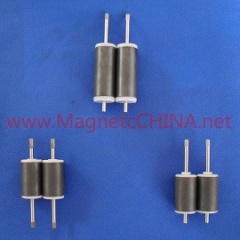
sintered ferrite magnet
10.0 USD
| Min. Order: | 1000 Piece/Pieces |
|---|---|
| Trade Term: | FOB |
| Payment Terms: | L/C, T/T, WU |
| Supply Ability: | 1000000pcs per month |
| Place of Origin: | Zhejiang |
Company Profile
| Location: | Ningbo, Zhejiang, China (Mainland) |
|---|---|
| Business Type: | Manufacturer, Trading Company |
Product Detail
| Means of Transport: | Ocean |
|---|---|
| Application: | Others |
| Shape: | Coil |
| Type: | Permanent |
| Composite: | Ferrite Magnet |
| Brand Name: | able magnet |
| composite: | ferrite magnet |
| Production Capacity: | 1000000pcs per month |
| Packing: | packing as customer's request |
| Delivery Date: | Within 30 days |
Product Description
Product name:sintered ferrite magnet
Developed in the late 1950's Sintered Ferrite or Ceramic magnets are manufactured from a composite powder containing 80% Iron oxide and 20% Barium or Strontium oxide. This powder is die pressed into a component that is then sintered in a furnace at approximately 1200°C.
Ferrites suit a wide range of applications due to their low cost. They are readily available in blocks, rings and discs. Principal applications are DC motors, loudspeakers, reed switch operation, magnetic separator assemblies and general holding devices such as pot magnets. The unmagnetised blocks are machined using diamond cutting machines to match customers' exact specification.
Ferrite has an excellent resistance to demagnetisation and can be magnetised before or after assembly without danger of losing any performance. It can be used in operating temperatures ranging from -40°C to + 250°C. However it does have a poor temperature coefficient losing approximately 0.2% of remanence per degree C when heated above zero.
Sintered Ferrite will not corrode even in salt-water applications. It also has good chemical stability, with the only exceptions being concentrated acids such as hydro-chloric.
With mechanical properties similar to ceramics or porcelain, it means that only grinding techniques can be used to machine these products. Care is required during handling due to their brittle nature.


| TYPICAL MAGNETIC AND PHYSICAL SPECIFICATIONS AT 20°C | ||||||||||||||
| MSS GRADE | DIN | Br | bHc | jHc | (BH) max | Magnatising Force (Minimum) | Max. working temp (°C) | Density (g/cc) | Rev Temp Coeff.of Br % °C | |||||
| T | Gauss | kA/m | Oersted | kA/m | Oersted | kJ/m3 | MGO | kA/m | Oersted | |||||
| FER1 | 8/22 | .220 | 2200 | 136 | 1700 | 220 | 2750 | 8 | 1.0 | 600 | 7500 | 250 | 4.8 | -0.19 |
| FER2 | 28/18 | .400 | 4000 | 160 | 2000 | 185 | 2300 | 28 | 3.5 | 800 | 10000 | 250 | 5.0 | -0.19 |
| FER3 | 26/26 | .370 | 3700 | 240 | 3000 | 260 | 3250 | 26 | 3.3 | 800 | 10000 | 250 | 4.9 | -0.19 |




.jpg)


.jpg)